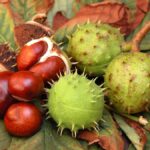Half a peach poached in syrup served with a scoop of vanilla ice cream topped with raspberry purée: peach Melba.
Barely chilled peach slices served with sugar and cream: peach Mom.
Auguste Escoffier—the most famous chef of his time–created peach Melba in 1892 in honor of the Australian opera singer Nellie Melba.
Peach Mom has been served much longer. It remains a favorite.
The success of any peach dish is a tender and sweet peach. The key to finding a tender and sweet peach is a gentle squeeze. A soft-fleshed peach is ready for the table or eating out of hand. It will be sweet and juicy and melt in your mouth.
Peaches ripen with warming weather. There are early, mid-season, and late-season ripening peaches so depending upon where you live and the variety of peaches available peach season can stretch from May to Halloween.
Serving peaches
Use peaches fresh, cooked, dried, canned, candied, or frozen.
- Add fresh sliced peaches to tarts crêpes, fruit salads, gelatin salads, yogurts, ice creams, sorbets, and soufflés. Use peaches to make jelly, jam, marinade, juice, compote, liqueurs, and brandy.
- Use sliced and sugared peaches on top of a shortcake or soaked in wine or champagne for dessert.
- Peaches can accompany savory dishes such as seafood, poultry, and pork; first, drizzle them with vinaigrette.
- The blood peach is more tart than white- or yellow-fleshed peaches. Blood peaches are good for eating out of hand or used in sauces, syrups, and preserves.
- Serve peeled and sliced with cereal, pancakes, and waffles.
- Add to fruit, ham, or poultry salads.
- Serve with savory dishes such as seafood, poultry, and pork; first drizzle with vinaigrette.
- Sauté, bake, or grill and serve alongside grilled or roasted poultry.
- Serve slices with sour cream and brown sugar.
- Serve with raspberry sauce and ice cream to make peach Melba.
- Spoon slices over the shortcake.
- Add slices to tarts, crêpes, soufflés, yogurts, ice creams, and sorbets.
- Use it to make jelly, jam, marinade, juice, compote, liqueurs, and brandy.
- Drop peach halves in glasses of sparkling wine.
Favorite peach recipes
Cooking peaches
Peaches can be baked, grilled, poached, and sautéed. Peaches do not gain flavor when cooked but they do hold their shape. Peaches can be used in recipes calling for nectarines.
- Baking. Peel, halve, and pit peaches. Glaze and bake until hot (about 25 minutes).
- Grilling. Peel, halve, and pit peaches. Coat all sides with lemon juice. Grill until hot and streaked with brown (6 to 8 minutes).
- Poaching. Peel, halve, and pit. Coat or sprinkle with lemon juice to prevent browning. Simmer in poaching liquid until tender when pierced (5 to 7 minutes).
- Sautéing. Peel and pit peaches; cut into ½-inch-thick slices and sprinkle with lemon juice. Sauté until hot (3 to 5 minutes).
About peaches
There are more than 2,000 varieties of peaches. Peaches grow wherever the weather warms in the spring and summer and the temperatures do not fall below 0º F (-17º C) in the winter.
The peach tree can grow from 16 to 26 feet (4.8-8 m) tall. It’s deciduous, and its pink flowers emerge before its leaves open in spring.
Peaches can be yellow-fleshed, white-fleshed, and even red-fleshed. (Red-fleshed peaches are often called “blood peaches.”) The flesh of a ripe peach will be juicy, sweet, and fragrant. A white or greenish-white-fleshed peach is more perishable but sweeter and juicier than a yellow-fleshed peach.
The skin color of the peach can vary from dull green through yellows and oranges to blush reds depending on the variety. Most peaches have an edible soft downy fluff on their skin (although some people may be allergic to peach skin). The fruit is usually 2½ to 3½ inches (6.4-8.8 cm) in diameter.
The peach is a relative of the apricot, almond, cherry, and plum. All of these have edible kernels or stones. The stone of a peach is usually about 1 inch (2.5 cm) long.
Peaches are sometimes classified by how their stones cling to their flesh. That may also say something about when the peach ripens.
A clingstone peach will be firm textured and its flesh will adhere to the stone. Clingstone peaches usually mature early and are used primarily for cooking or canning.
Semi-freestone peaches usually ripen mid-season. They are good for cooking or eating out of hand.
Freestone peaches usually ripen later in the season. Because the texture of a freestone peach is usually soft, the pit will often fall away freely. These peaches are best for using fresh.
How to choose a peach
- Select peaches that are sweetly fragrant, unblemished, and not too hard. A ripe peach will be soft to the touch.
- The color of a peach—such as a crimson blush–indicates variety, not maturity.
- Look for peaches that are yellow or cream-colored at the stem end with a well-defined crease or partition line. A peach with a pronounced partition line will split easily.
- Avoid green-colored peaches. A peach with green shoulders on the stem end will not be ripe. Avoid peaches with large flattened bruises or shriveling skin.
How to prepare a peach
- To easily peel a peach, cut an X at the end opposite the stem and then dip the whole fruit in boiling water for 10 to 30 seconds. Cool it in cold water to stop the effect of the heat, then peel.
- Peach flesh will oxidize and turn brown if it comes in contact with air. To avoid browning, sprinkle the flesh with lemon juice.
- Ripen peaches in a cool room by placing the stem end down. When the peaches are fragrant they are ripe.
- Wash the fruit before eating.
How to store peaches
- Store peaches with care. Do not pack them too closely. Peaches will spoil rapidly if bruised.
- Ripe peaches will keep for 3 to 4 days at room temperature, slightly longer in the refrigerator. Allow peaches to return to room temperature before eating.
- Peaches can be frozen or canned, but it is best to remove the stone first to be sure there is no bitter taste.
- Ripe peaches can be frozen as a compote or purée.
Peach flavor partners
Peaches have a flavor affinity for almonds, apricots, champagne, cherries, cream, ginger, honey, pistachios, plums, pork, poultry, red wine, sour cream, sugar, vanilla, walnuts, and white wine.
Peach nutrition
Peaches are a good source of potassium and contain vitamins C and A and niacin.
About peaches
The largest peach producers in the world are Italy, the United States, China, and Greece. Next to the apple, the peach is the most widely cultivated fruit in the world.
Today’s peaches are believed to be descended from the Chinese wild peach. Peaches were first cultivated in China more than 2,500 years ago. In China, the peach is a symbol of longevity and immortality.
From China, the peach spread to ancient India and Persia where it was discovered by the armies of Alexander the Great. The peach was given the Latin species name persica because it was believed to be native to Persia. The peach is sometimes called a “Persian apple.”
The Spaniards brought the peach to the New World in the fifteenth century.
The botanical name of the peach is Prunus persica.
Also of interest:
How to Grow Peaches and Nectarines
Related articles:
Planning the Home Fruit Garden
Garden Planning Books at Amazon:
- Vegetable Garden Almanac & Planner
- Kitchen Garden Grower’s Guide Vegetable Encyclopedia
- Vegetable Garden Grower’s Guide
- Tomato Grower’s Answer Book
More kitchen tips:
Bring your harvest to the table. Kitchen prep tips and easy recipes for the vegetables you grow. Click below for vegetable prep and recipes you can use now.
- Almonds
- Apples
- Apricot
- Aprium
- Artichoke
- Arugula
- Asparagus
- Avocado
- Bamboo Shoots
- Banana
- Basil
- Beans, Dried
- Beans. Long
- Beans, Shell
- Beans, Snap
- Beets
- Bitter Melon
- Blackberry
- Bok Choy
- Broccoli
- Broccoli Raab
- Brussels Sprouts
- Cabbage
- Cardoon
- Carrots
- Cauliflower
- Celeriac
- Celery
- Chard
- Chayote Squash
- Cherimoya
- Cherries
- Chestnut
- Chickpea
- Chinese Cabbage
- Chives
- Cilantro
- Citron
- Clementine
- Collards
- Coriander
- Corn, Sweet
- Corn, Baby
- Corn Salad, Mache
- Cranberry
- Cress
- Cucumber
- Daikon
- Dandelion
- Dill
- Eggplant
- Endive, Belgian
- Endive and Escarole
- Fava Beans
- Fig
- Florence Fennel
- Garlic
- Ginger
- Grapefruit
- Grapes
- Guava
- Horseradish
- Jerusalem Artichoke
- Jicama
- Jujube
- Kale
- Kiwifruit
- Kohlrabi
- Kumquat
- Leeks
- Lemongrass
- Lemons
- Lettuce
- Lime
- Mache (Corn Salad)
- Mandarin Orange
- Mango
- Maple Syrup
- Marjoram
- Melons
- Michihili
- Mint
- Mizuna
- Mushrooms
- Mushrooms, Cremini
- Mustard Greens
- Napa Cabbage
- Nectarine
- Okra
- Olives
- Olive oil
- Onions
- Oranges
- Oregano
- Parsley
- Parsley Root
- Parsnips
- Passion Fruit
- Pawpaw
- Peaches
- Pears
- Peas, Garden Snap
- Peas, Snow
- Pei Tsai
- Peppers, Chili
- Peppers, Sweet
- Persimmon
- Pineapple
- Pineapple Guava
- Plantain
- Plums
- Pluots
- Pomegranate
- Potatoes
- Prickly Pear
- Pumpkin
- Quince
- Radicchio
- Radishes
- Raspberries
- Rosemary
- Rhubarb
- Rutabaga
- Sage
- Salsify
- Sauerkraut
- Savory
- Shallots
- Sorrel
- Spinach
- Squash, Summer
- Squash, Winter
- Strawberries
- Sunchokes
- Sunflower
- Sweet Potato
- Swiss Chard
- Tangerine
- Taro
- Tarragon
- Thyme
- Tomatillo
- Tomato
- Turnip
- Turnip Greens
- Yams















